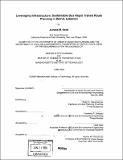Leveraging infrastructure : sustainable bus rapid transit route planning in Beirut, Lebanon
Author(s)
Nabti, Jumana M., 1976-
DownloadFull printable version (20.12Mb)
Other Contributors
Massachusetts Institute of Technology. Dept. of Civil and Environmental Engineering.
Advisor
Ralph A. Gakenheimer.
Terms of use
Metadata
Show full item recordAbstract
This thesis applies the concepts of urban design, public transportation planning, economic development, and sustainability, to the routing and site plan of a two-kilometer bus rapid transit (BRT) line segment into downtown Beirut, Lebanon; linking a 20- kilometer BRT corridor to the region's core. Previous routing of the segment, which used typical transportation engineering processes produced routes that would degrade the line's quality of service and/or the adjacent land uses. While one route was preferred, none were compelling enough to be advanced to the next planning stage. This thesis explores the possibility that, by expanding the criteria, the route selection and design process can be used to determine an alignment that not only supports high quality transit service, but leverages the capital investment in public transportation to improve environmental quality, economic development, community livability, and transit network connectivity in the areas it serves. In turn, the inclusion of these factors should aid in successful BRT implementation by broadening the base of supporters, and by acknowledging and catering to the physical, social, and political complexity of the project and the project area, substantially increasing project benefits. The project identified a broad range of routes, and the primary institutions and constituencies affected in order to develop an alignment and site programming method to optimize support. Using public transportation infrastructure improvements as a catalyst and a mechanism by which to improve other aspects of the urban system, if successful, should not only improve the implementation likelihood, but also create greater incentives to continually expand the transit system.
Description
Thesis (M.C.P.)--Massachusetts Institute of Technology, Dept. of Urban Studies and Planning; and, (S.M.)--Massachusetts Institute of Technology, Dept. of Civil and Environmental Engineering, 2004. Includes bibliographical references (p. 135-138).
Date issued
2004Department
Massachusetts Institute of Technology. Department of Civil and Environmental Engineering; Massachusetts Institute of Technology. Department of Urban Studies and PlanningPublisher
Massachusetts Institute of Technology
Keywords
Urban Studies and Planning., Civil and Environmental Engineering.